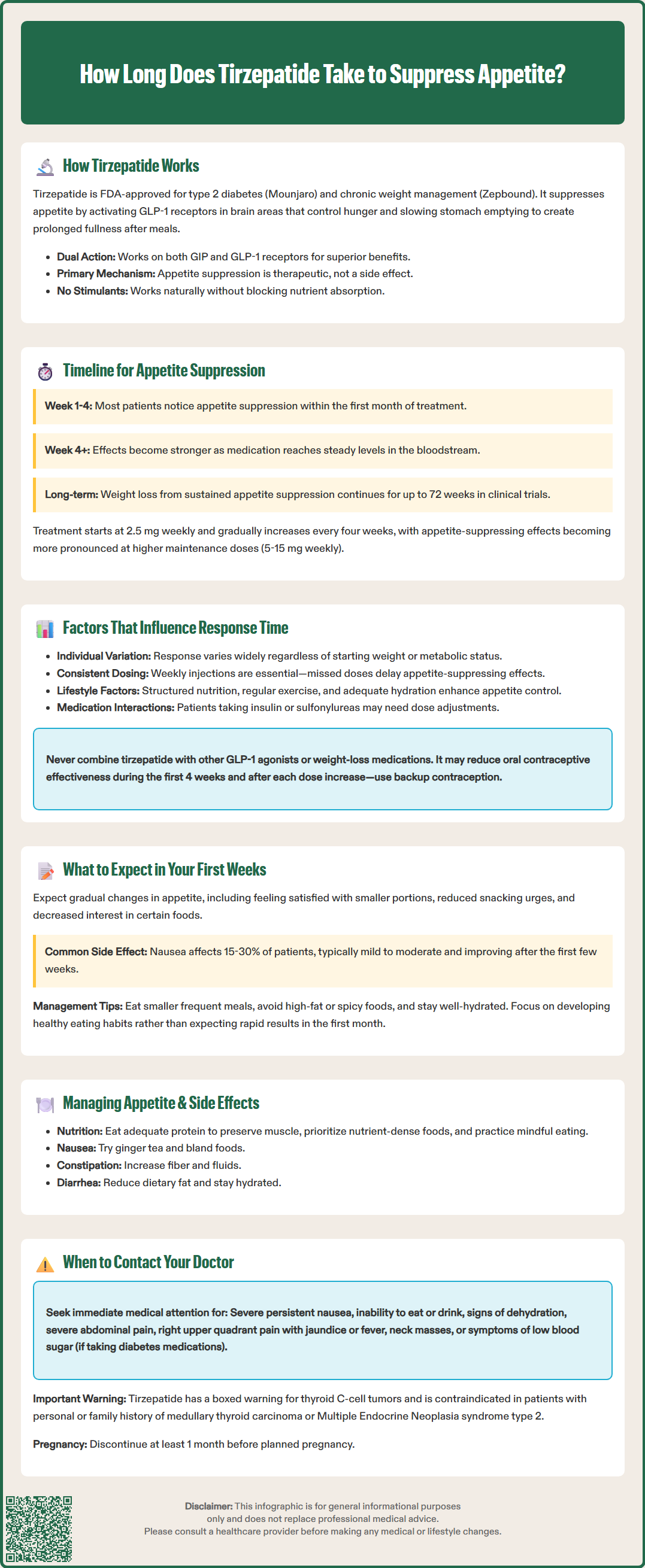LOSE WEIGHT WITH MEDICAL SUPPORT — BUILT FOR MEN
- Your personalised programme is built around medical care, not willpower.
- No generic diets. No guesswork.
- Just science-backed results and expert support.
Find out if you’re eligible

How long does it take for tirzepatide to suppress appetite? Most patients begin noticing appetite suppression within one to four weeks of starting tirzepatide, though individual responses vary. Tirzepatide is a dual GIP and GLP-1 receptor agonist approved by the FDA for type 2 diabetes (Mounjaro) and chronic weight management (Zepbound). The medication works by activating receptors in the brain that control hunger, slowing gastric emptying, and reducing food cravings. Understanding the timeline and factors affecting appetite suppression helps patients set realistic expectations and optimize treatment outcomes during the initial weeks of therapy.
Quick Answer: Most patients experience noticeable appetite suppression within one to four weeks of starting tirzepatide, with effects becoming more pronounced as doses are gradually increased.
Tirzepatide is a dual glucose-dependent insulinotropic polypeptide (GIP) and glucagon-like peptide-1 (GLP-1) receptor agonist approved by the FDA for type 2 diabetes management in adults (Mounjaro) and chronic weight management in adults with BMI ≥30 kg/m² or ≥27 kg/m² with at least one weight-related comorbidity (Zepbound). Its appetite-suppressing effects stem from its mechanism of action that targets multiple pathways involved in hunger regulation and satiety.
The medication works primarily by activating GLP-1 receptors in the brain, particularly in areas such as the hypothalamus and brainstem that control appetite and food intake. This activation slows gastric emptying, meaning food remains in the stomach longer, creating a prolonged sensation of fullness after meals. While this slowing effect may attenuate over time, central appetite effects often persist. Additionally, tirzepatide influences neural circuits that regulate hunger signals, reducing the desire to eat and decreasing overall caloric intake.
The dual agonist activity—targeting both GIP and GLP-1 receptors—is hypothesized to provide benefits beyond single-receptor agonists. Researchers propose that GIP receptor activation may complement GLP-1 signaling effects on glucose metabolism, though the precise mechanisms in humans continue to be studied. Clinical trials have demonstrated that tirzepatide produces dose-dependent reductions in body weight, with participants reporting decreased hunger and increased satiety during the initial weeks of treatment.
It is important to understand that tirzepatide's appetite suppression is not simply a side effect but rather a therapeutic mechanism that contributes to its efficacy in weight management. The medication does not work through stimulant pathways or by blocking nutrient absorption, making its safety profile distinct from older weight-loss medications. Tirzepatide should not be coadministered with other GLP-1 receptor agonists or other tirzepatide-containing products.

Many patients begin experiencing noticeable appetite suppression within the first one to four weeks of starting tirzepatide, though individual responses vary considerably. Clinical trial data and real-world experience suggest that the onset of appetite reduction often correlates with the medication reaching steady-state concentrations in the bloodstream, which typically occurs after approximately 4 weeks of consistent weekly dosing.
During the initial titration phase, patients commonly start with a lower dose (2.5 mg weekly for Mounjaro, 2.5 mg for Zepbound) to minimize gastrointestinal side effects. At this starting dose, some individuals report subtle changes in appetite within the first week, while others may not notice significant effects until the dose is increased. The FDA-approved titration schedule involves gradual dose escalation every four weeks, allowing the body to adjust while progressively enhancing appetite suppression.
Appetite-suppressing effects generally become more pronounced as patients reach maintenance doses (5 mg to 15 mg weekly, depending on individual response and tolerability). Research from the SURMOUNT clinical trials indicates that weight loss—which reflects sustained appetite suppression—continues through 72 weeks of treatment, with significant effects observed within the first few months. However, meaningful appetite reduction sufficient to support dietary changes often manifests earlier, within the first month of therapy for many individuals.
It is essential to recognize that appetite suppression is not an all-or-nothing phenomenon. Many patients describe a gradual diminishment of hunger cues, reduced food cravings (particularly for high-calorie or high-fat foods), and earlier satiety during meals. If treatment is discontinued, clinical evidence from the SURMOUNT-4 trial shows that appetite typically returns and partial weight regain occurs, highlighting the importance of continued therapy for sustained effects.
Several physiological and clinical factors can affect how rapidly an individual experiences appetite suppression with tirzepatide. Individual metabolic differences may influence response time, though the relationship between baseline characteristics and onset of effects requires further study. Response variability is common, with some patients experiencing earlier effects than others regardless of starting weight or metabolic status.
Dosing consistency is critical for optimal results. Tirzepatide has a half-life of approximately five days, and missing doses or inconsistent administration can delay the achievement of steady-state drug levels, thereby postponing appetite-suppressing effects. According to the FDA prescribing information, if a dose is missed, patients should administer the missed dose as soon as possible if within 4 days (96 hours) of the scheduled dose. If more than 4 days have passed, skip the missed dose and administer the next dose on the regularly scheduled day. The weekly dosing day can be changed if at least 3 days (72 hours) have passed between doses.
Concomitant medications and medical conditions can also influence tirzepatide's efficacy. Medications that affect gastric motility or gastrointestinal function may interact with tirzepatide's mechanism of slowing gastric emptying. Importantly, tirzepatide may decrease the efficacy of oral contraceptives, particularly during the first 4 weeks after initiation and after each dose escalation; non-oral contraception or backup methods are recommended during these periods. For patients with diabetes using insulin or sulfonylureas, blood glucose monitoring and dose adjustments may be needed to reduce hypoglycemia risk.
Lifestyle factors, including dietary composition, meal timing, and physical activity levels, can modulate the perceived intensity of appetite suppression. Patients who combine tirzepatide with structured nutrition plans and regular exercise often report more consistent and satisfactory appetite control. Adequate hydration and appropriate protein intake are particularly important, as dehydration can increase the risk of acute kidney injury, especially with severe gastrointestinal side effects. Tirzepatide should not be coadministered with other GLP-1 receptor agonists or anti-obesity medications.
The initial weeks of tirzepatide therapy represent an adjustment period during which patients should anticipate both therapeutic effects and potential side effects. Most commonly, individuals notice changes in their relationship with food—reduced portion sizes feel satisfying, snacking urges diminish, and previously appealing foods may seem less desirable. These changes typically emerge gradually rather than abruptly, allowing for behavioral adaptation.
Gastrointestinal side effects are the most frequently reported adverse events during the early treatment phase. According to the FDA prescribing information, nausea affects approximately 15-30% of patients (dose-dependent) and is usually mild to moderate in severity, often improving after the first few weeks as tolerance develops. Other common effects include occasional vomiting, diarrhea, constipation, and abdominal discomfort. These symptoms generally peak within the first few days after dose initiation or escalation and tend to resolve within several days.
Patients should be counseled on practical strategies to minimize discomfort during this adjustment period. Eating smaller, more frequent meals rather than large portions can help manage nausea and early satiety. Avoiding high-fat, greasy, or heavily spiced foods may reduce gastrointestinal upset. Staying well-hydrated is essential, particularly if experiencing nausea or diarrhea, to prevent dehydration and reduce the risk of acute kidney injury.
It is important to maintain realistic expectations regarding weight loss during the first month. While appetite suppression may begin early, significant weight reduction typically requires sustained treatment over several months. Patients should focus on establishing healthy eating patterns and recognizing their body's new hunger and fullness cues rather than expecting rapid dramatic changes. Patients with diabetes who are also taking insulin or sulfonylureas should monitor for signs of hypoglycemia and contact their healthcare provider if it occurs. Any concerning symptoms—such as severe persistent nausea, inability to tolerate oral intake, signs of dehydration, severe abdominal pain, or right upper quadrant pain (which could indicate gallbladder disease)—warrant prompt communication with the prescribing healthcare provider.
Successful long-term management with tirzepatide requires a proactive approach to both leveraging its appetite-suppressing benefits and mitigating potential adverse effects. Patients should work closely with their healthcare team to optimize dosing, address side effects, and integrate the medication into a comprehensive weight management or diabetes care plan.
Dietary modifications can significantly enhance treatment tolerability and effectiveness. Consuming adequate protein helps preserve lean muscle mass during weight loss and promotes satiety. Protein needs should be individualized based on factors like body weight, activity level, and kidney function; a registered dietitian can help determine appropriate targets. Prioritizing nutrient-dense foods—vegetables, fruits, whole grains, and lean proteins—ensures adequate micronutrient intake despite reduced caloric consumption. Patients should eat slowly and mindfully, stopping when comfortably satisfied rather than completely full, as overeating can trigger nausea and discomfort.
For persistent gastrointestinal side effects, several management strategies may help. Ginger tea, small amounts of bland foods, and avoiding lying down immediately after eating can alleviate nausea. If constipation develops, increasing dietary fiber, fluid intake, and physical activity often provides relief; stool softeners or gentle laxatives may be appropriate for some patients. Conversely, if diarrhea persists, maintaining hydration and temporarily reducing dietary fat may be beneficial.
Regular monitoring and communication with healthcare providers are essential throughout treatment. Patients should report any severe or persistent side effects, as dose adjustments or temporary treatment interruption may be necessary. Warning signs requiring immediate medical attention include severe abdominal pain (which could indicate pancreatitis), persistent vomiting with inability to keep down fluids, right upper quadrant pain, jaundice or fever (possible gallbladder disease), or symptoms of thyroid nodules (neck mass, difficulty swallowing, persistent hoarseness). Tirzepatide has a boxed warning regarding thyroid C-cell tumors and is contraindicated in patients with a personal or family history of medullary thyroid carcinoma (MTC) or in patients with Multiple Endocrine Neoplasia syndrome type 2 (MEN2).
Tirzepatide is not recommended during pregnancy and should be discontinued at least 1 month before a planned pregnancy. Women of childbearing potential should be aware that tirzepatide may reduce the effectiveness of oral contraceptives, particularly during the first 4 weeks after initiation and after each dose escalation; non-oral contraception or backup methods are recommended during these periods. Long-term success with tirzepatide depends on using the medication as a tool to support sustainable lifestyle changes rather than relying solely on appetite suppression for weight management.
Most patients begin experiencing noticeable appetite suppression within one to four weeks of starting tirzepatide, though some individuals report subtle changes within the first week. Appetite-suppressing effects generally become more pronounced as doses are gradually increased every four weeks.
The most common side effects are gastrointestinal, including nausea (affecting 15-30% of patients), vomiting, diarrhea, constipation, and abdominal discomfort. These symptoms are usually mild to moderate, peak within the first few days after starting or increasing doses, and typically improve after several weeks as tolerance develops.
No, tirzepatide should not be coadministered with other GLP-1 receptor agonists, other tirzepatide-containing products, or other anti-obesity medications. Patients should inform their healthcare provider about all medications they are taking to avoid potential interactions.
All medical content on this blog is created using reputable, evidence-based sources and is regularly reviewed for accuracy and relevance. While we strive to keep our content current with the latest research and clinical guidelines, it is intended for general informational purposes only.
This content is not a substitute for professional medical advice, diagnosis, or treatment. Always consult a licensed healthcare provider with any medical questions or concerns. Use of this information is at your own risk, and we are not liable for any outcomes resulting from its use.